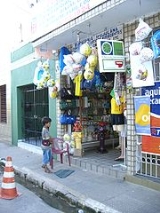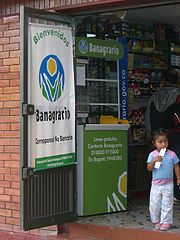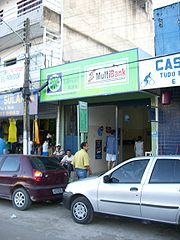
Banking agent
Encyclopedia
A banking agent is a retail or postal outlet contracted by a financial institution or a mobile network operator to process clients’ transactions. Rather than a branch teller, it is the owner or an employee of the retail outlet who conducts the transaction and lets clients deposit, withdraw, and transfer funds, pay their bills, inquire about an account balance, or receive government benefits or a direct deposit from their employer. Banking agents can be pharmacies, supermarkets, convenience stores, lottery outlets, post offices, and many more.
Globally, these retailers and post offices are increasingly utilized as important distribution channels for financial institutions. The points of service range from post offices in the Outback of Australia where clients from all banks can conduct their transactions, to rural France where the bank Credit Agricole uses corner stores to provide financial services, to small lottery outlets in Brazil at which clients can receive their social payments and access their bank accounts.
Banking agents are usually equipped with a combination of point-of-sale (POS)
card reader, mobile phone, barcode scanner to scan bills for bill payment transactions, Personal Identification Number identification number (PIN) pads, and sometimes personal computers (PCs)
that connect with the bank’s server using a personal dial-up or other data connection. Clients that transact at the agent use a magstripe bank card
or their mobile phone to access their bank account or e-wallet respectively. Identification of customers is normally done through a PIN, but could also involve biometrics. With regard to the transaction verification, authorization, and settlement platform, banking agents are similar to any other remote bank channel.
Local regulation will determine if financial institutions are allowed to work through retail outlets. Regulators generally determine what kind of, if any, financial institutions are permitted to contract banking agents, what products can be offered at the retail outlets, how financial institutions have to handle cash transport, Know Your Customer
requirements, consumer protection
, and other operational areas.
Banking agents are the backbone of mobile banking
, i.e., performing transactions over a mobile device, most often a mobile phone. To enable clients to convert cash into electronic money and vice versa which can send be sent over their mobile phone, clients will have to visit a branch, automated teller machine (ATM)
, or banking agent. Especially in remote and rural locations, where cash is still the most important way to pay and transact, a mobile banking service is dependent on banking agents to enable clients to effectively use the service.
In case the agent’s credit line had reached its limits, and the agent’s bank account does not have sufficient funds, to cover the received funds, the POS will block and can only be deblocked if the funds have been deposited in the next bank account.
The transaction process for banking services using a bank card is simple:



Latinamerica is the region with the strongest development towards banking agents. Here governments concerned about expanding financial sector infrastructure have adjusted regulation and are providing incentives for banks to reach new geographies and new client segments through banking agents.
Brazil is probably the most developed market where banking agents have significantly increased financial system infrastructure. Seventy-four institutions are currently managing around 105,000 points of sale in Brazil that reach all 5,561 municipalities. Within only 5 years, the banking agent network facilitated 12.4m new bank accounts and today the network comprises 56 percent of all points of sale in the Brazilian financial system. Financial institutions in other Latin-American markets such as Peru, Colombia, and Mexico have started to learn from the Brazilian experience, adjusted their regulation, and established their own banking agent networks. Pioneers in other regions can be found in Kenya, Mongolia, South Africa, and the Philippines.
Chile
Colombia:
For more information on Colombia's banking agents, please visit: www.bancadelasoportunidades.co.gov
India
Mexico
Peru
Ivatury, Gautam. Using Technology to Build Inclusive Financial Systems. CGAP Focus Note No. 32. Washington D.C.: January 2006
Ivatury, G. and Timothy Lyman. Use of Agents in Branchless Banking for the Poor: Rewards, Risks, and Regulation. CGAP Focus Note No. 38. Washington D.C.: October 2006
Lyman, T., Pickens, M. and David Porteous. Regulating Transformational Branchless Banking. CGAP Focus Note No. 43. Washington D.C.: January 2008:
Ivatury, Gautam and Ignacio Mas. The Early Experience with Branchless Banking. CGAP Focus Note No 46. Washington D.C.: 2008
Mas, Ignacio and Hannah Siedek. Banking through Networks of Retail Agents. CGAP Focus Note No. 47. Washington D.C.: 2008
Siedek, Hannah. Extending Financial Services with Banking Agents. CGAP Brief. Washington D.C.: 2008
Banking agent research with more country examples
Kumar, Anjali et al. Expanding Bank Outreach through Retail Partnerships: Correspondent Banking in Brazil World Bank Working Paper No. 85. The World Bank: Washington DC. 2006
Prieto Ariza, Ana Maria. Ampliación del Acceso a los Servicios Financieros Mediante Corresponsales No Bancarios: La Experiencia de Brasil y Perú. Documento Asobancaria No. 3. Asociación Bancaria Y de Entidades Financieras de Colombia: Bogota. 2006
Jacob, Katy. Retailers as Financial Services Providers: The Potential and Pitfalls of This Burgeoning Distribution Channel. The Center for Financial Innovation: Chicago, IL. 2005.
Globally, these retailers and post offices are increasingly utilized as important distribution channels for financial institutions. The points of service range from post offices in the Outback of Australia where clients from all banks can conduct their transactions, to rural France where the bank Credit Agricole uses corner stores to provide financial services, to small lottery outlets in Brazil at which clients can receive their social payments and access their bank accounts.
Banking agents are usually equipped with a combination of point-of-sale (POS)
Point of sale
Point of sale or checkout is the location where a transaction occurs...
card reader, mobile phone, barcode scanner to scan bills for bill payment transactions, Personal Identification Number identification number (PIN) pads, and sometimes personal computers (PCs)
Personal computer
A personal computer is any general-purpose computer whose size, capabilities, and original sales price make it useful for individuals, and which is intended to be operated directly by an end-user with no intervening computer operator...
that connect with the bank’s server using a personal dial-up or other data connection. Clients that transact at the agent use a magstripe bank card
Magnetic stripe card
A magnetic stripe card is a type of card capable of storing data by modifying the magnetism of tiny iron-based magnetic particles on a band of magnetic material on the card...
or their mobile phone to access their bank account or e-wallet respectively. Identification of customers is normally done through a PIN, but could also involve biometrics. With regard to the transaction verification, authorization, and settlement platform, banking agents are similar to any other remote bank channel.
Local regulation will determine if financial institutions are allowed to work through retail outlets. Regulators generally determine what kind of, if any, financial institutions are permitted to contract banking agents, what products can be offered at the retail outlets, how financial institutions have to handle cash transport, Know Your Customer
Know your customer
Know Your Customer refers to both:* The activities of customer due diligence that financial institutions and other regulated companies must perform to identify their clients and ascertain relevant information pertinent to doing financial business with them* And the bank regulation which governs...
requirements, consumer protection
Consumer protection
Consumer protection laws designed to ensure fair trade competition and the free flow of truthful information in the marketplace. The laws are designed to prevent businesses that engage in fraud or specified unfair practices from gaining an advantage over competitors and may provide additional...
, and other operational areas.
Rationale for banking agents
Banking agents help financial institutions to divert existing customers from crowded branches providing a “complementary” , often more convenient channel. Other financial institutions, especially in developing markets, use agents to reach an “additional” client segment or geography. Reaching poor clients in rural areas is often prohibitively expensive for financial institutions since transaction numbers and volumes do not cover the cost of a branch. In such environments banking agents that piggy back on existing retail infrastructure – and lower set up and running cost - can play a vital role in offering many low-income people their first-time access to a range of financial services. Also, low-income clients often feel more comfortable banking at their local store than walking into a marble branch.Banking agents are the backbone of mobile banking
Mobile Banking
Mobile banking is a term used for performing balance checks, account transactions, payments, credit applications and other banking transactions through a mobile device such as a mobile phone or Personal Digital Assistant . The earliest mobile banking services were offered over SMS...
, i.e., performing transactions over a mobile device, most often a mobile phone. To enable clients to convert cash into electronic money and vice versa which can send be sent over their mobile phone, clients will have to visit a branch, automated teller machine (ATM)
Automated teller machine
An automated teller machine or automatic teller machine, also known as a Cashpoint , cash machine or sometimes a hole in the wall in British English, is a computerised telecommunications device that provides the clients of a financial institution with access to financial transactions in a public...
, or banking agent. Especially in remote and rural locations, where cash is still the most important way to pay and transact, a mobile banking service is dependent on banking agents to enable clients to effectively use the service.
Transaction process
For the client, there is no difference in accessing his or her bank account at the agent or in a branch or at an ATM. However, besides signing a contract with the financial institution it will be working for, the banking agent also has to open a bank account at the same. In addition, the store has to deposit a certain amount of cash into that account which will serve as the banking agent’s “working capital.” In many cases, rather than asking the agent to come up with the cash deposit, the financial institution will extend the store a credit line. The size of the credit line is normally not standardized, but adapted individually to each agent depending on its size, the expected volume of transactions and how long the agent has already been working with the bank. This is how the credit line will be used during each transaction:- Client withdraws money (“cash-out” transaction): agent account is credited in same amount.
- Client deposits money (“cash-in” transaction): agent account is debited in same amount.
In case the agent’s credit line had reached its limits, and the agent’s bank account does not have sufficient funds, to cover the received funds, the POS will block and can only be deblocked if the funds have been deposited in the next bank account.
The transaction process for banking services using a bank card is simple:
- An existing bank client presents his card at the agent and requests a specific transaction and the amount to be withdrawn, deposited, or transferred;
- The agent selects the type of transaction on the POS device or personal computer, enters the amount, swipes the client’s card through the device, and lets the client enter his PIN;
- A General Packet Radio Service (GPRS)General Packet Radio ServiceGeneral packet radio service is a packet oriented mobile data service on the 2G and 3G cellular communication system's global system for mobile communications . GPRS was originally standardized by European Telecommunications Standards Institute in response to the earlier CDPD and i-mode...
, dial up, or satellite communication connects with the bank’s server to authorize the transaction; - Once the transaction has been authorized, the device prints the client’s receipt.
Banking agent set ups
There are principally three ways banks have used to set up their equipment and marketing material within a store.A. Cashier
This set up is primarily being used for individual stores. Transaction volume should be relatively low and being processed by the store’s staff in addition to their traditional sales. The technology equipment is located behind store’s general cashier. Posters and marketing material will be limited to small section next to POS device and a small sign outside the store.
B. Stand
This set up in which the bank sets up a little stand is used if transaction volume is larger and justify one staff member dedicated to man the POS device. Some financial institution prefer this set up since clients do not feel as much as “banking” in a store and the bank’s brand is much more visible.
C. Dedicated store
This set up is similar to a mini-branch, i.e., a small shop with around 1-3 tellers, but transactions are processed by non-bank staff.
Experience with banking agents
Pioneering banks, microfinance institutions, and mobile operators started to experiment with banking agent networks in various countries around the world such as Brazil, Peru, Colombia, Kenya, Mexico, Pakistan, the Philippines, and South Africa.Latinamerica is the region with the strongest development towards banking agents. Here governments concerned about expanding financial sector infrastructure have adjusted regulation and are providing incentives for banks to reach new geographies and new client segments through banking agents.
Brazil is probably the most developed market where banking agents have significantly increased financial system infrastructure. Seventy-four institutions are currently managing around 105,000 points of sale in Brazil that reach all 5,561 municipalities. Within only 5 years, the banking agent network facilitated 12.4m new bank accounts and today the network comprises 56 percent of all points of sale in the Brazilian financial system. Financial institutions in other Latin-American markets such as Peru, Colombia, and Mexico have started to learn from the Brazilian experience, adjusted their regulation, and established their own banking agent networks. Pioneers in other regions can be found in Kenya, Mongolia, South Africa, and the Philippines.
Links to financial institutions operating banking agents
BrazilChile
Colombia:
For more information on Colombia's banking agents, please visit: www.bancadelasoportunidades.co.gov
India
- State Bank of IndiaState Bank of IndiaThe State Bank of India is the largest Indian banking and financial services company with its headquarters in Mumbai, India. It is state-owned. The bank traces its ancestry to British India, through the Imperial Bank of India, to the founding in 1806 of the Bank of Calcutta, making it the oldest...
(Eko India Financial ServicesEko India Financial ServicesEko India Financial Services Pvt. Ltd. is an Indian financial service company, which is a business correspondent service for State Bank of India and ICICI Bank, India's top two largest banks, and provides no-frills bank accounts and deposit, withdrawal and remittance services to customers ...
) - ICICI BankICICI BankICICI Bank Ltd. is India's second largest financial services company headquartered in Mumbai, India. It offers a wide range of banking products and financial services to corporate and retail customers through a variety of delivery channels and through its specialised subsidiaries in the areas of...
(Eko India Financial ServicesEko India Financial ServicesEko India Financial Services Pvt. Ltd. is an Indian financial service company, which is a business correspondent service for State Bank of India and ICICI Bank, India's top two largest banks, and provides no-frills bank accounts and deposit, withdrawal and remittance services to customers ...
)
Mexico
Peru
Further reading
CGAP Agent FAQsIvatury, Gautam. Using Technology to Build Inclusive Financial Systems. CGAP Focus Note No. 32. Washington D.C.: January 2006
Ivatury, G. and Timothy Lyman. Use of Agents in Branchless Banking for the Poor: Rewards, Risks, and Regulation. CGAP Focus Note No. 38. Washington D.C.: October 2006
Lyman, T., Pickens, M. and David Porteous. Regulating Transformational Branchless Banking. CGAP Focus Note No. 43. Washington D.C.: January 2008:
Ivatury, Gautam and Ignacio Mas. The Early Experience with Branchless Banking. CGAP Focus Note No 46. Washington D.C.: 2008
Mas, Ignacio and Hannah Siedek. Banking through Networks of Retail Agents. CGAP Focus Note No. 47. Washington D.C.: 2008
Siedek, Hannah. Extending Financial Services with Banking Agents. CGAP Brief. Washington D.C.: 2008
Banking agent research with more country examples
Kumar, Anjali et al. Expanding Bank Outreach through Retail Partnerships: Correspondent Banking in Brazil World Bank Working Paper No. 85. The World Bank: Washington DC. 2006
Prieto Ariza, Ana Maria. Ampliación del Acceso a los Servicios Financieros Mediante Corresponsales No Bancarios: La Experiencia de Brasil y Perú. Documento Asobancaria No. 3. Asociación Bancaria Y de Entidades Financieras de Colombia: Bogota. 2006
Jacob, Katy. Retailers as Financial Services Providers: The Potential and Pitfalls of This Burgeoning Distribution Channel. The Center for Financial Innovation: Chicago, IL. 2005.

